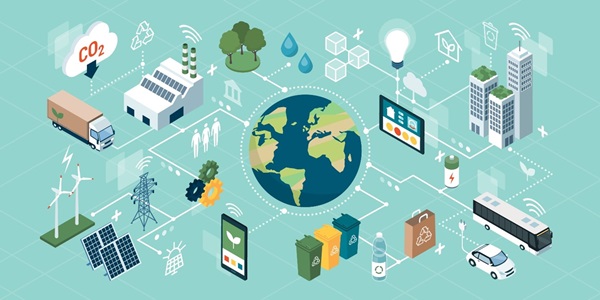
Climate change is a pressing global issue that requires proactive and adaptive solutions.
In this article, we explore ten industries at the forefront of pioneering climate change adaptation.
From agriculture and renewable energy to construction and healthcare, these sectors are taking bold steps towards mitigating the effects of climate change.
By employing innovative strategies and embracing sustainable practices, these industries are not only safeguarding their own future but also contributing to a healthier and more resilient planet.
Renewable Energy
Renewable energy sources are revolutionizing the global energy industry by providing sustainable and environmentally friendly alternatives to traditional fossil fuels. The innovation and cost-effectiveness of renewable energy technologies have played a crucial role in their widespread adoption.
The development of solar, wind, hydro, and geothermal power has led to significant advancements in energy generation and distribution. These technologies have become increasingly efficient and cost-competitive, making them attractive options for both businesses and individuals.
Additionally, government policies and incentives have played a pivotal role in promoting the transition towards renewable energy. Governments worldwide have implemented various measures such as tax incentives, feed-in tariffs, and renewable energy standards to encourage the adoption of clean energy sources. These policies have created a supportive environment for renewable energy investments, driving further innovation and growth in the sector.

As a result, renewable energy has emerged as a viable solution to address the challenges of climate change and energy security while promoting economic development and energy independence.
Agriculture
Agriculture plays a critical role in climate change adaptation, and there are several key points to consider.
First, sustainable farming practices can help mitigate the impact of climate change by promoting soil health, reducing greenhouse gas emissions, and conserving water resources.
Second, crop diversification can enhance resilience by reducing the vulnerability of agricultural systems to climate-related risks.
Lastly, implementing water conservation techniques, such as efficient irrigation systems and rainwater harvesting, can help ensure the availability of water for both crops and livestock in the face of changing climate patterns.
Sustainable Farming Practices
In the realm of climate change adaptation, the agricultural sector is at the forefront of implementing sustainable farming practices. As the need for resilient and environmentally friendly food production grows, farmers are adopting innovative techniques to ensure the long-term sustainability of their operations.
Some of the key sustainable farming practices being implemented include:

- Conservation Agriculture: This approach focuses on maintaining healthy soil by minimizing soil disturbance, using cover crops, and practicing crop rotation. These practices help to improve soil fertility, retain moisture, and reduce erosion.
- Precision Farming: By using advanced technologies such as GPS, sensors, and drones, farmers can optimize the use of resources like water, fertilizers, and pesticides. This precision farming approach minimizes waste and reduces the environmental impact of agricultural activities.
- Agroforestry: Integrating trees with crops and livestock can enhance biodiversity, improve soil health, and provide additional income streams for farmers. Agroforestry systems also sequester carbon, mitigating climate change.
- Organic Farming: By avoiding synthetic fertilizers and pesticides, organic farming promotes the use of natural and sustainable practices. Organic farming methods prioritize soil health, biodiversity, and the welfare of animals.
Crop Diversification for Resilience
One way that the agricultural sector is addressing climate change adaptation is through the practice of crop diversification for resilience.
Crop diversification involves growing a variety of crops in a specific area to reduce the vulnerability of the agricultural system to climate-related risks. This approach helps to ensure that even if one crop fails due to extreme weather events or pests, other crops can still thrive.
Additionally, crop rotation, which is a key component of crop diversification, helps to improve soil health and fertility. By rotating crops, farmers can prevent the build-up of pests and diseases, reduce soil erosion, and enhance nutrient availability.
Water Conservation Techniques
Implementing water conservation techniques is crucial for the agricultural sector to adapt to climate change and ensure the sustainable use of water resources. To achieve this, farmers can employ various irrigation techniques and practices that minimize water wastage and maximize efficiency.
These techniques include:
- Drip irrigation: This method delivers water directly to the plant's root zone, reducing evaporation and allowing for precise water application.
- Micro-sprinklers: These small sprinklers distribute water evenly, reducing runoff and increasing water absorption.
- Precision irrigation scheduling: By monitoring soil moisture levels and using weather data, farmers can schedule irrigation based on actual plant needs, avoiding overwatering.
- Rainwater harvesting: Collecting and storing rainwater can supplement irrigation needs during dry periods, reducing reliance on groundwater and surface water sources.
Construction
The construction industry plays a crucial role in the implementation of climate change adaptation strategies through the integration of sustainable practices and resilient infrastructure.
With the increasing awareness of the environmental impacts of construction activities, there has been a growing emphasis on adopting green building techniques and using sustainable materials.

Green building techniques focus on minimizing the environmental footprint of construction projects and enhancing their resilience to climate change. This includes incorporating energy-efficient designs, utilizing renewable energy sources, and implementing water conservation measures.
Sustainable materials, such as recycled or locally sourced materials, are also being used to reduce the industry's reliance on non-renewable resources and decrease waste generation.
By embracing these practices, the construction industry can contribute to mitigating climate change and promoting sustainable development. It can help reduce greenhouse gas emissions, conserve natural resources, and create healthier and more resilient built environments.
Through collaboration and innovation, the construction industry can lead the way in implementing climate change adaptation strategies and building a more sustainable future.
Insurance
The insurance sector plays a crucial role in promoting resilience and mitigating risks associated with climate change in various industries, including construction. As climate change continues to impact the world, insurance companies are adapting their policies and practices to address the growing risks.
Here are some ways in which insurance is contributing to climate change adaptation:
- Developing innovative insurance products: Insurance companies are creating new policies that specifically cover climate-related risks, such as extreme weather events and rising sea levels.
- Encouraging sustainable practices: Insurers are incentivizing policyholders to adopt sustainable practices by offering lower premiums for green buildings and renewable energy installations.
- Supporting climate research and data analysis: Insurance companies are investing in research and data analysis to better understand the impacts of climate change and develop more accurate risk models.
- Offering coverage for medical waste management: With the rise in healthcare waste due to the pandemic, insurance companies are providing coverage for proper disposal and management of medical waste, reducing the associated environmental risks.
Tourism
Tourism plays a significant role in the global economy. However, it also has the potential to contribute to climate change. To address this, there is a growing need for sustainable travel options that minimize environmental impact while providing economic benefits to local communities.

Another important aspect is striking a balance between tourism and conservation. This balance is crucial for protecting natural resources and preserving the unique cultural heritage of destinations.
Sustainable Travel Options
A key aspect of sustainable travel options lies in the integration of environmentally friendly practices into the tourism industry. As more travelers seek eco-friendly accommodations and experiences, the industry has responded with innovative solutions. Here are some sustainable travel options that promote environmental stewardship:
- Eco-friendly accommodations: Hotels and resorts are implementing green practices such as energy-efficient lighting, water conservation measures, and waste reduction programs. Some properties even use renewable energy sources to power their facilities.
- Carbon offset programs: Travelers can now offset the carbon emissions generated from their trips by participating in carbon offset programs. These initiatives invest in projects that reduce greenhouse gas emissions, such as reforestation or renewable energy development.
- Sustainable transportation: Many destinations promote the use of public transportation, cycling, or walking to reduce carbon emissions. Electric vehicle charging stations and bike-sharing programs are also becoming more prevalent.
- Local and sustainable experiences: Travelers can support local communities by engaging in sustainable activities such as farm-to-table dining, community-based tourism, and wildlife conservation projects.
Impact on Local Communities
One significant aspect of the impact of sustainable travel options on local communities is the increase in economic opportunities. Sustainable travel practices, such as eco-tourism and responsible travel, have the potential to generate revenue and create jobs within local communities. By engaging with local businesses, hotels, and tour operators, travelers can contribute directly to the local economy, supporting small businesses and promoting community development.
Community engagement plays a crucial role in ensuring that the benefits of tourism are distributed equitably among local residents. Furthermore, sustainable travel options can have a positive social impact by encouraging cultural exchange, fostering understanding and empathy between tourists and local communities.
Balancing Tourism and Conservation
With a focus on balancing tourism and conservation, the integration of sustainable travel practices contributes to the preservation of natural resources and cultural heritage. As the tourism industry continues to grow, it is crucial to ensure that this growth is sustainable and does not have a negative impact on local communities.
Here are some key strategies that can help achieve this balance:
- Encouraging responsible tourism practices, such as minimizing waste, supporting local businesses, and respecting local customs and traditions.
- Implementing conservation initiatives, such as protecting fragile ecosystems, wildlife habitats, and natural landmarks.
- Engaging local communities in decision-making processes to ensure their needs and concerns are taken into account.
- Educating tourists about the importance of conservation and providing opportunities for them to actively participate in conservation efforts.
Transportation
The transportation sector plays a pivotal role in addressing the challenges of climate change adaptation. As the sector responsible for moving goods and people, it has a significant impact on greenhouse gas emissions and energy consumption. To mitigate these effects, it is crucial to focus on two key areas: transportation infrastructure and electric vehicles.

Investing in resilient transportation infrastructure is essential for adapting to climate change. This includes constructing roads, bridges, and ports that can withstand extreme weather events and rising sea levels. Additionally, integrating sustainable design principles into transportation infrastructure can reduce emissions and promote energy efficiency.
Furthermore, transitioning to electric vehicles (EVs) is a powerful climate adaptation strategy. EVs produce zero tailpipe emissions, reducing air pollution and greenhouse gas emissions. Governments and businesses can support this transition by providing incentives for EV adoption, expanding charging infrastructure, and collaborating with automakers to develop affordable and reliable EV models.
Water Management
Water management is crucial in addressing the challenges of climate change adaptation, particularly in relation to the impacts on agriculture, renewable energy, construction, and transportation. Effective management of water resources is essential to mitigate the effects of water scarcity and drought.
Here are some key strategies that can be employed:
- Implementing efficient irrigation techniques to minimize water wastage and optimize water use in agriculture.
- Investing in water storage infrastructure, such as reservoirs and dams, to capture and store water during periods of abundance for use during dry spells.
- Promoting the use of water-saving technologies and practices in the construction industry, such as low-flow plumbing fixtures and rainwater harvesting systems.
- Developing and implementing comprehensive drought management plans that include early warning systems, water rationing measures, and drought-resistant crop varieties.
Forestry
In the field of forestry, industries are pioneering climate change adaptation through strategic management and sustainable practices. Forest management plays a crucial role in mitigating the impacts of climate change while ensuring the long-term sustainability of timber resources. By adopting innovative approaches, such as selective harvesting and reforestation, the timber industry is actively contributing to climate change adaptation.
Sustainable forest management practices aim to maintain the health and resilience of forest ecosystems, enabling them to better withstand the changing climate. This includes protecting biodiversity, managing fire risks, and promoting natural regeneration. Furthermore, the timber industry is embracing technologies that enhance forest monitoring and enable more precise decision-making.
Through these efforts, the forestry sector is not only adapting to climate change but also contributing to global efforts in combating it.

Fisheries
Fisheries are actively engaging in climate change adaptation through the implementation of sustainable practices and the management of fish stocks. As climate change continues to impact marine ecosystems, it becomes crucial for fisheries to adopt strategies that ensure the long-term viability of their operations.
Here are some key ways in which fisheries are addressing this challenge:
- Enhancing fisheries management: Fisheries are implementing science-based management strategies to ensure the sustainable use of fish stocks. This includes setting catch limits, implementing size and season restrictions, and establishing marine protected areas.
- Promoting sustainable fishing practices: Fisheries are adopting methods such as selective fishing gear and reducing bycatch to minimize the impact on non-target species and the ecosystem.
- Investing in research and innovation: Fisheries are actively supporting and participating in research initiatives to better understand the impacts of climate change on fish populations and ecosystems. This knowledge helps inform decision-making and adaptation strategies.
- Collaborating with stakeholders: Fisheries are engaging with local communities, governments, and conservation organizations to develop and implement collaborative management approaches that balance environmental sustainability with socio-economic considerations.
Healthcare
Healthcare plays a crucial role in addressing the impacts of climate change.
One key area is medical waste management, as healthcare facilities generate significant amounts of waste that can contribute to environmental pollution.
Additionally, healthcare professionals need to focus on preventing and managing climate-related diseases, such as vector-borne illnesses, as changing weather patterns can affect the prevalence and distribution of these diseases.
Medical Waste Management
The healthcare industry is taking proactive measures to address the challenges posed by climate change through effective management of medical waste. As the industry continues to grow, so does the amount of waste generated, making it crucial to find sustainable solutions.
Here are some key initiatives being implemented:

- Implementation of proper medical waste disposal procedures to ensure the safe handling and disposal of hazardous waste.
- Adoption of recycling initiatives to reduce the environmental impact of medical waste, such as segregating recyclable materials like plastics and paper.
- Encouragement of waste reduction practices, including the use of reusable items and the implementation of digital systems to reduce paper waste.
- Collaboration with waste management companies to develop innovative technologies and methods for the proper treatment and disposal of medical waste.
As the healthcare industry focuses on addressing the challenges posed by climate change, it continues its efforts in preventing climate-related diseases through various proactive measures.
One key strategy is the development of climate resilient infrastructure in healthcare facilities. This includes designing hospitals and clinics that can withstand extreme weather events, such as floods and storms, to ensure uninterrupted healthcare services.
Additionally, the implementation of early warning systems plays a crucial role in preventing the spread of climate-related diseases. These systems help healthcare professionals and communities prepare for and respond to outbreaks by providing timely information on weather patterns, disease vectors, and potential health risks.
Sustainable Healthcare Facilities
To promote climate change adaptation in the healthcare industry, a subtopic worth exploring is the implementation of sustainable healthcare facilities. By incorporating sustainable healthcare design and eco-friendly healthcare products, the industry can reduce its carbon footprint and contribute to a healthier environment.
Here are some key aspects to consider:
- Energy-efficient buildings: Sustainable healthcare facilities can be designed to use renewable energy sources such as solar power, reducing reliance on fossil fuels and decreasing greenhouse gas emissions.
- Water conservation: Implementing water-saving technologies and practices, such as low-flow faucets and toilets, can help reduce water consumption and promote sustainability.
- Waste management: Proper waste segregation and recycling programs can minimize the environmental impact of healthcare facilities.
- Green procurement: Choosing eco-friendly healthcare products, such as non-toxic cleaning supplies and sustainable medical equipment, can contribute to a greener healthcare system.
Frequently Asked Questions
How Does Renewable Energy Contribute to Reducing Greenhouse Gas Emissions?
Renewable energy technology plays a critical role in reducing greenhouse gas emissions by replacing fossil fuel-based energy sources with cleaner alternatives such as wind, solar, and hydroelectric power, thereby mitigating the effects of climate change.
What Are the Main Challenges Faced by the Agriculture Industry in Adapting to Climate Change?
The agriculture industry faces significant challenges in adapting to climate change. These challenges include unpredictable weather patterns, increased pest and disease pressures, water scarcity, and the need for sustainable agricultural practices to ensure long-term food security and resilience.

What Sustainable Construction Practices Can Help Mitigate the Impacts of Climate Change?
Green building techniques and climate resilient infrastructure are essential in mitigating the impacts of climate change in the construction industry. By incorporating sustainable materials, energy-efficient designs, and resilient infrastructure, buildings can adapt to changing climate conditions and minimize their environmental footprint.
How Does the Insurance Industry Play a Role in Supporting Climate Change Adaptation Efforts?
The insurance industry plays a crucial role in supporting climate change adaptation efforts by providing coverage for climate-related risks, promoting resilient infrastructure investments, and incentivizing sustainable practices through premium discounts and risk mitigation partnerships.
Promoting eco-friendly travel and implementing sustainable tourism initiatives are key strategies for addressing the challenges of climate change. By encouraging responsible travel practices and supporting environmentally conscious tourism, the industry can contribute to mitigating the impacts of climate change.
 Business & FinanceHealth & MedicineTechnologyLifestyle & CultureScience & EnvironmentWorld NewsPrivacy PolicyTerms And Conditions
Business & FinanceHealth & MedicineTechnologyLifestyle & CultureScience & EnvironmentWorld NewsPrivacy PolicyTerms And Conditions
